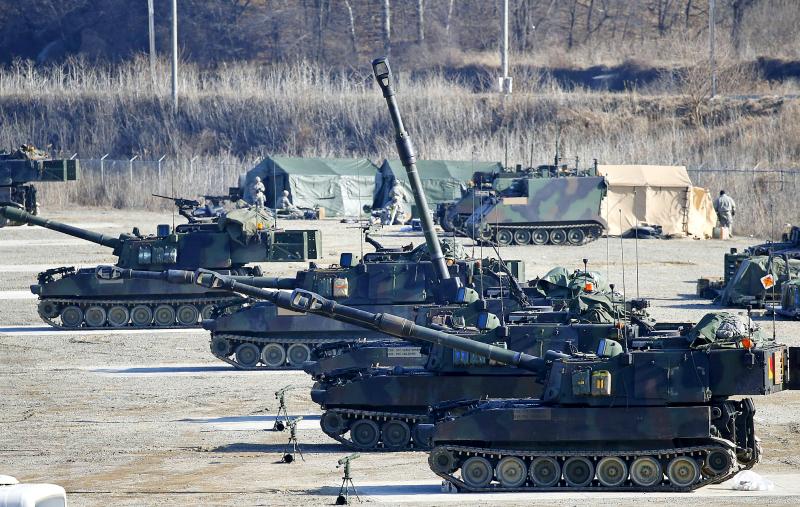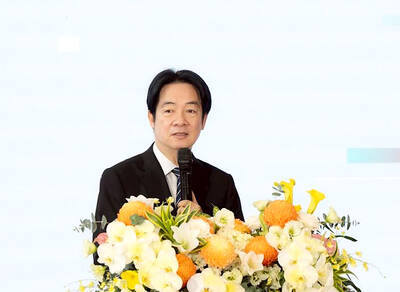The Ministry of National Defense yesterday said it was considering alternative weapons options after the US informed it that the delivery of an artillery system would be delayed due to a “crowded” production line.
Washington last year approved the potential sale of 40 155mm M109A6 Paladin self-propelled howitzers to Taiwan in a deal valued at up to US$750 million.
Eight of the artillery systems were originally set for delivery next year, with 16 more expected in 2024 and 16 in 2025.

Photo: Reuters
However, the ministry said that because of a “crowded” production line for the M109A6, the US said it would not happen until 2026 at the earliest.
It is considering other precision and long-range alternative weapons systems, including truck-based rocket launchers made by Lockheed Martin Corp called the High Mobility Artillery Rocket System, or HIMARS, the ministry added.
It did not say why the production line was snarled, but the US has been ramping up its military support and supply of equipment for Ukraine following Russia’s invasion.
Taiwan is undertaking a military modernization program to improve its capabilities to fend off a Chinese attack, including with precision weapons such as missiles.
Asked about the delay, National Policy Foundation associate research fellow Chieh Chung (揭仲) yesterday said that it would severely affect national defense capabilities by delaying automation of the artillery command.
While Washington has been suggesting that Taiwan improve its defenses by lengthening compulsory military service and establishing a territorial defense force, it virtually canceled the M109A6 deal, he said.
“It seems like a logical contradiction,” he said, adding that it might indicate a serious communication problem between the two sides.
The M109A6 would be invaluable to Taiwan’s forces, as it is not only highly mobile, but also able to obtain the enemy’s targeting information, calculate and order a strike automatically, all in less than a minute, Chieh said.
It would therefore go a long way toward automating the artillery command, shortening engagement time and improving accuracy, all of which are critical to national defense operations, he said.
Most artillery systems must wait for precise targeting information from a central command, which could take about five minutes from enemy launch, he said.
The delay would make it difficult to deal with the fast-paced and highly mobile forces China would send in a first strike, Chieh added.
This first wave of elite Chinese forces would likely maintain air superiority, using various types of reconnaissance equipment, including tactical drones, he said.
While the military might have many traditional towed artillery units, they would not last long on the battlefield due to their lack of mobility and long engagement time, Chieh added.

MISINFORMATION: The generated content tends to adopt China’s official stance, such as ‘Taiwan is currently governed by the Chinese central government,’ the NSB said Five China-developed artificial intelligence (AI) language models exhibit cybersecurity risks and content biases, an inspection conducted by the National Security Bureau (NSB) showed. The five AI tools are: DeepSeek, Doubao (豆包), Yiyan (文心一言), Tongyi (通義千問) and Yuanbao (騰訊元寶), the bureau said, advising people to remain vigilant to protect personal data privacy and corporate business secrets. The NSB said it, in accordance with the National Intelligence Services Act (國家情報工作法), has reviewed international cybersecurity reports and intelligence, and coordinated with the Ministry of Justice Investigation Bureau and the National Police Agency’s Criminal Investigation Bureau to conduct an inspection of China-made AI language

LIMITS: While China increases military pressure on Taiwan and expands its use of cognitive warfare, it is unwilling to target tech supply chains, the report said US and Taiwan military officials have warned that the Chinese People’s Liberation Army (PLA) could implement a blockade within “a matter of hours” and need only “minimal conversion time” prior to an attack on Taiwan, a report released on Tuesday by the US Senate’s China Economic and Security Review Commission said. “While there is no indication that China is planning an imminent attack, the United States and its allies and partners can no longer assume that a Taiwan contingency is a distant possibility for which they would have ample time to prepare,” it said. The commission made the comments in its annual

CHECKING BOUNDARIES: China wants to disrupt solidarity among democracies and test their red lines, but it is instead pushing nations to become more united, an expert said The US Department of State on Friday expressed deep concern over a Chinese public security agency’s investigation into Legislator Puma Shen (沈伯洋) for “secession.” “China’s actions threaten free speech and erode norms that have underpinned the cross-strait ‘status quo’ for decades,” a US Department of State spokesperson said. The Chongqing Municipal Public Security Bureau late last month listed Shen as “wanted” and launched an investigation into alleged “secession-related” criminal activities, including his founding of the Kuma Academy, a civil defense organization that prepares people for an invasion by China. The spokesperson said that the US was “deeply concerned” about the bureau investigating Shen

‘TROUBLEMAKER’: Most countries believe that it is China — rather than Taiwan — that is undermining regional peace and stability with its coercive tactics, the president said China should restrain itself and refrain from being a troublemaker that sabotages peace and stability in the Indo-Pacific region, President William Lai (賴清德) said yesterday. Lai made the remarks after China Coast Guard vessels sailed into disputed waters off the Senkaku Islands — known as the Diaoyutai Islands (釣魚台) in Taiwan — following a remark Japanese Prime Minister Sanae Takaichi made regarding Taiwan. Takaichi during a parliamentary session on Nov. 7 said that a “Taiwan contingency” involving a Chinese naval blockade could qualify as a “survival-threatening situation” for Japan, and trigger Tokyo’s deployment of its military for defense. Asked about the escalating tensions